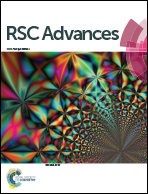An ionic aqueous pseudocapacitor system: electroactive ions in both a salt electrode and redox electrolyte†
Abstract
We designed a new type of ionic pseudocapacitor system with excellent contributions from ionic-state redox mediators, including a redox couple [Fe(CN)6]3−/[Fe(CN)6]4− in the electrolyte and redox cations in highly electroactive colloid electrodes. The highest pseudocapacitance value of 12 658 mF cm−2 was obtained, which is a 7-fold increase in the specific capacitance of the CoCl2 electrode for K3Fe(CN)6 in a KOH alkaline electrolyte at a current density of 20 mA cm−2 and at a potential interval of 0.55 V. The currently designed supercapacitor systems show a versatile strategy to design high-performance supercapacitors with CoCl2, CuCl2, NiCl2, and FeCl3 electrodes.


 Please wait while we load your content...
Please wait while we load your content...